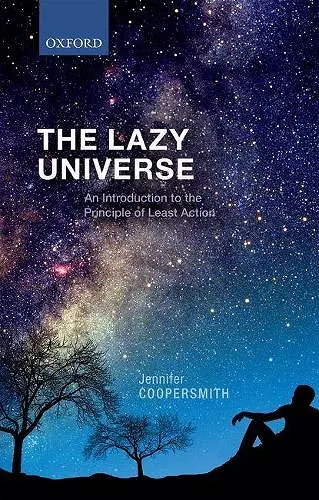The Lazy Universe
An Introduction to the Principle of Least Action
Format:Hardback
Publisher:Oxford University Press
Published:11th May '17
Currently unavailable, and unfortunately no date known when it will be back

This is a rare book on a rare topic: it is about 'action' and the Principle of Least Action. A surprisingly well-kept secret, these ideas are at the heart of physical science and engineering. Physics is well known as being concerned with grand conservatory principles (e.g. the conservation of energy) but equally important is the optimization principle (such as getting somewhere in the shortest time or with the least resistance). The book explains: why an optimization principle underlies physics, what action is, what `the Hamiltonian' is, and how new insights into energy, space, and time arise. It assumes some background in the physical sciences, at the level of undergraduate science, but it is not a textbook. The requisite derivations and worked examples are given but may be skim-read if desired. The author draws from Cornelius Lanczos's book "The Variational Principles of Mechanics" (1949 and 1970). Lanczos was a brilliant mathematician and educator, but his book was for a postgraduate audience. The present book is no mere copy with the difficult bits left out - it is original, and a popularization. It aims to explain ideas rather than achieve technical competence, and to show how Least Action leads into the whole of physics.
Jennifer Coopersmith has written a most welcome book, the first historically and philosophically motivated full study since two classics written nearly a half-century ago... [She] has attempted and succeeded admirably I believe in her aim to write a modern book on the history and philosophy of the action principles, as well as to give the technical details. * Chris Gray, American Journal of Physics *
Any careful reader of this book will seek out the monograph without fail and benefit from its perusal... I have no hesitations in recommending this book to any physical scientist or engineer who wants to understand variational principles better. * M. P. Gururajan, Contemporary Physics *
Recommended. * CHOICE *
[C]ontagious enthusiasm and a sense of humour unusual in this kind of literature ... The first part is excellent reading for anybody with an interest in the history and philosophy of science. I also recommend the book to students in physics and mathematics who are willing to dig deeper into this subject after taking classes in analytical mechanics, and I believe that it is accessible to any student in STEM disciplines. Practitioners in physics from any sub-discipline will enjoy a refresh and a different point of view that puts their tools of the trade in a broader context. * Andrea Giammanco, CERN Courier *
Inspired by the monumental work of Lanczos, Jennifer Coopersmith has constructed a beautiful exposition of the philosophical basis underlying classical mechanics. It has enough technical meat to be interesting to an expert, while remaining accessible to a novice. * Gerald Jay Sussman, Panasonic Professor of Electrical Engineering, Massachusetts Institute of Technology *
This is a well written and comprehensible presentation of some of the most fascinating and fundamental principles which theoretical physics has uncovered. The author has done a great job in making accessible 'as if-laws' to a broader audience. * Helmut Pulte, Ruhr University Bochum, Germany *
This book has a general audience: every practicing physicist -- and a specific audience: every physics textbook writer. Envision and teach physics powerfully and directly with energy, action, and the Principle of Least Action. * Edwin F. Taylor, Senior Research Scientist Emeritus, Massachusetts Institute of Technology *
ISBN: 9780198743040
Dimensions: 222mm x 149mm x 23mm
Weight: 508g
280 pages